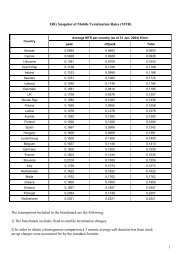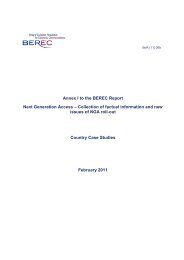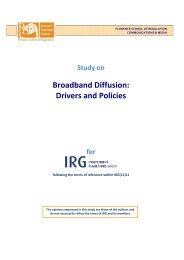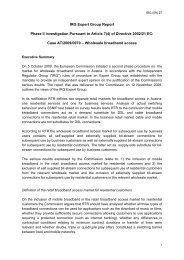Create successful ePaper yourself
Turn your PDF publications into a flip-book with our unique Google optimized e-Paper software.
4.4 Beta estimati<strong>on</strong><br />
<strong>IRG</strong>-WG RA (<str<strong>on</strong>g>07</str<strong>on</strong>g>) <strong>WACC</strong> Master Doc<br />
Beta is a measure of the risk of the risky asset relative to the market risk. In theory, the <strong>on</strong>ly<br />
risk that is captured by beta is systematic risk, which is the risk that cannot be eliminated by<br />
the investor through diversificati<strong>on</strong>.<br />
The beta reflects the extent to which possible future returns are expected to co-vary with the<br />
expected returns <strong>on</strong> a broad portfolio of assets, i.e. the degree of co-movement between the<br />
company’s returns and the market returns. The higher the value of beta, the greater the<br />
systematic risk faced by holders of the firm's equity. Forward-looking estimates of returns <strong>on</strong><br />
particular stocks and <strong>on</strong> the market as a whole are not readily available; therefore estimating<br />
beta is not an easy task. Several approaches can be used in estimating beta:<br />
4.4.1 Historical beta<br />
Beta estimates are generally obtained through regressi<strong>on</strong> analysis of historical evidence of<br />
the relati<strong>on</strong>ship between the company returns and the market returns.<br />
Thus, for publicly traded firms betas can be estimated by regressing stock’s returns (Rj),<br />
including both dividends and price appreciati<strong>on</strong>, against the market returns (Rm):<br />
Rj = a + b Rm<br />
Where “a” is the Intercept from the regressi<strong>on</strong> and “b” is the slope of the regressi<strong>on</strong>, which<br />
corresp<strong>on</strong>ds to the covariance (Rj, Rm) / σ 2 (Rm) and is the beta of the stock. There are a<br />
number of services that provide such estimates including L<strong>on</strong>d<strong>on</strong> Business School,<br />
Bloomberg, DataStream, Standard & Poor’s and Value Line.<br />
However, using historic returns to estimate future values of beta raises the questi<strong>on</strong> of what<br />
is the correct estimati<strong>on</strong> period and frequency. In respect to the estimati<strong>on</strong> period, as we<br />
have seen before, the most recent period possible is likely to embody market expectati<strong>on</strong>s<br />
about future returns. On the other hand, the values of beta fluctuate over the business cycle.<br />
Therefore taking <strong>on</strong>ly a recent period risks missing informati<strong>on</strong> and biasing the results,<br />
suggesting that betas should be calculated over as l<strong>on</strong>g a period as possible. There is<br />
therefore a trade-off between the relevance of the estimati<strong>on</strong> period and the need for a<br />
sufficiently l<strong>on</strong>g time period to ensure the regressi<strong>on</strong> results are robust. Most estimate<br />
services use period ranging from 2 to 5 years for the regressi<strong>on</strong>.<br />
The relevant frequency should be defined in order to have a data set of a reas<strong>on</strong>able size,<br />
which can generate a statistically significant estimate of the value of beta.<br />
A beta calculated through regressi<strong>on</strong> analysis of historical informati<strong>on</strong> provides an<br />
approximati<strong>on</strong>. However, estimati<strong>on</strong> errors are likely because betas may vary significantly<br />
over time. Therefore, the estimati<strong>on</strong> of the relevant beta from historical informati<strong>on</strong> may need<br />
to be complemented with other forward-looking approach.<br />
20







